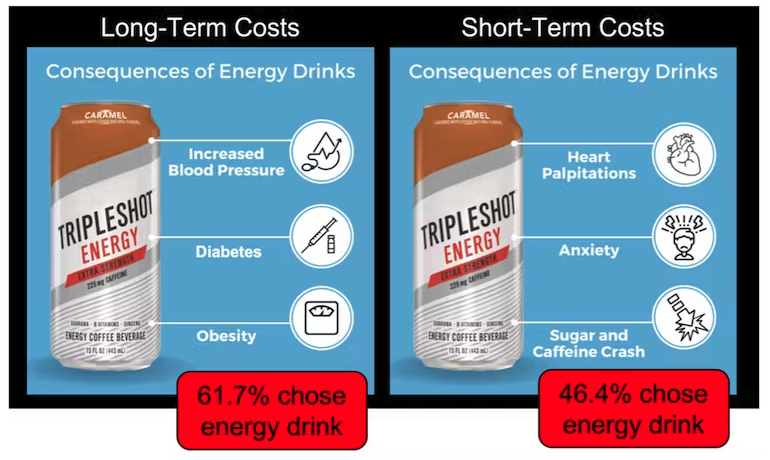 It’s a familiar start-of-the-year scene. You’ve committed to a healthier lifestyle and are determined that this time is going to be different. Your refrigerator is stocked with fruits and veggies, you’ve tossed out processed foods, and your workout routine is written in pen in your daily planner.
It’s a familiar start-of-the-year scene. You’ve committed to a healthier lifestyle and are determined that this time is going to be different. Your refrigerator is stocked with fruits and veggies, you’ve tossed out processed foods, and your workout routine is written in pen in your daily planner.
Yet, as you head out one morning, the tantalizing aroma of fresh doughnuts wafts through the air. How can you resist the call of this sugary treat and stick with your healthy choices?
 Conventional wisdom, grounded in years of research, suggests that the best way to resist unhealthy choices is to think about the long-term consequences. For example, you could consider how the added sugar from eating too many doughnuts can lead to diabetes and obesity. Thinking about these long-term consequences, the argument goes, should help you avoid indulging right now and better stick to your goals.
Conventional wisdom, grounded in years of research, suggests that the best way to resist unhealthy choices is to think about the long-term consequences. For example, you could consider how the added sugar from eating too many doughnuts can lead to diabetes and obesity. Thinking about these long-term consequences, the argument goes, should help you avoid indulging right now and better stick to your goals.
However, in our combined 25 years of experience investigating people’s self-control behavior and motivation, we have learned that, in the heat of the moment, people often overlook distant outcomes, diminishing the effectiveness of strategies focused on the long term.
In response, we propose three approaches, backed by recent research, to help you stick to healthier habits.
To resist temptation, think short term
One strategy to avoid indulging is to consider the short-term consequences of unhealthy behavior. We tested this approach in seven studies with over 4,000 participants.
In one study, we invited university students to view one of two public service announcements detailing reasons to avoid energy drinks. One message emphasized long-term costs of drinking high-sugar energy drinks, such as diabetes and obesity. The other stressed short-term costs, such as anxiety and a sugar and caffeine crash.
Students then had a choice between receiving an energy drink or another attractive prize. Those who read about the short-term costs were 25% less likely to choose the energy drink than those who read about the long-term costs.
In another study with a similar setup, participants read about either the short-term costs of eating sugar, the long-term costs of eating sugar, or they did not read about any downsides. Everyone then had to choose a delivery of cookies or a tote bag. Those who read about the short-term costs were 30% less likely to choose the cookies than those who read about the long-term costs and 45% less likely than those who didn’t read about any detriments to sugar.
We found that emphasizing short-term costs can also help you avoid other temptations. For alcohol, think about how excessive drinking can lead to poor sleep and hangovers. For fast food, think about how it can make you feel bloated or give you indigestion.
In our studies, immediate effects were a stronger motivator than long-term consequences that could take decades to occur. The takeaway is simple: To avoid indulging, think short term.
Focus on the fun of healthy options
Avoiding unhealthy foods is one thing. On the flip side, can you nudge yourself toward consuming more healthy foods?
Research that one of us (Kaitlin) conducted with behavioral scientist Ayelet Fishbach found that prompting people to focus on the good taste – rather than the health benefits – of foods such as apples and carrots increased consumption in the lab and the real world. These findings were independently replicated in an intervention at five university dining halls that used food labels focused on either tastiness or healthfulness.
This strategy can also promote other healthy behaviors, such as exercise. In one study, Kaitlin asked gymgoers to choose a weightlifting workout from a list of similarly difficult routines. The participants who were instructed to select a fun exercise completed more reps than those told to pick an exercise most useful for their long-term fitness goals.
Immediate rewards that result from pursuing long-term goals improve your experience right now, although they often go unnoticed. For this reason, focusing on the immediate versus delayed benefits of behaviors such as healthy eating and exercise can increase intrinsic motivation, making a behavior feel like its own reward and resulting in the immersed-in-an-activity feeling called “flow.”
Timing the reward sweet spot
Starting healthy behaviors is one important piece of the puzzle; another is sticking with these behaviors over time. One strategy for persistence is to use rewards to stay committed.
Research led by marketing professor Marissa Sharif, along with Kaitlin, involving over 5,000 people across eight experiments found that small, regular rewards were more effective for cultivating long-term commitment to healthy behavior such as exercising and flossing than were large, occasional rewards. Think watching 20 minutes of a guilty pleasure TV show each day you work out, rather than waiting to the end of the week to watch 80 minutes of TV to reward yourself for those four workouts.
But there’s a twist: Rewarding yourself too early may backfire. It seems rewards are most effective when people have to work to unlock them, after which they become regular. In other words, putting in initial effort while not being rewarded, followed by small, continual perks, is the most effective way to structure rewards.
In a study on exercise, Marissa and Kaitlin followed exercisers as they engaged in four initial workouts that came with no rewards. Then a work-to-unlock-rewards group began to receive small, continual rewards for each subsequent workout. They ended up persisting longer and completing more workouts than people in a lump-sum group who received a larger, occasional reward for every four workouts they finished.
A similar effect was evident in a 12-day study on tooth flossing. People in the work-to-unlock-rewards group – three days of flossing without rewards followed by daily rewards – flossed for more days than those who received continual rewards right way. Those who had to commit extra effort to unlock the rewards flossed 15% more days.
These studies suggest people can strategically incorporate rewards – with a short initial period without any rewards – into their routine to help them stick with healthy behaviors over time.
Resistance, enjoyment and persistence
Our research highlights three effective strategies to help you achieve your goals: prioritizing short-term consequences to resist temptation, finding enjoyment in long-term choices, and continually rewarding yourself for sustained persistence.
What’s great about these strategies is that you can adapt them to any personal goal you hold. For instance, if you’re finding it hard to swap social media for a book, consider reflecting on negative short-term consequences of endless scrolling. Or if carving out time for relaxation feels like a challenge, focus on the immediate benefits of engaging in meditative exercises.
By incorporating these evidence-based approaches, you can empower yourself to follow through on your long-term goals.
BIOS:
Professor Kaitlin Woolley is an associate professor of marketing at Cornell University. Professor Woolley studies consumer motivation and goal pursuit, with a focus on understanding what consumers value when pursuing their goals and how to use this to increase goal persistence. She also researches the influence of goal conflict on consumer choice, and the role food consumption plays in social connection. Woolley’s research has been published in journals and book chapters, including Journal of Consumer Research and Journal of Personality and Social Psychology. It has been featured in outlets such as the Wall Street Journal, the New York Times, Harvard Business Review, NPR, and Psychology Today.
At Cornell, Professor Woolley teaches the core marketing course and the consumer behavior course. Woolley earned a bachelor’s degree magna cum laude in psychology from Cornell University. She earned an MBA from the University of Chicago Booth School of Business. Her PhD is in behavioral science from the University of Chicago Booth School of Business.
Dr. Stillman’s research examines how cognition and motivation interact to produce behavior. In particular, by investigating the cognitive underpinnings of goal-pursuit, I hope to advance understanding of self-regulation – how people manage complex goal arrays. In doing so, I hope to provide insight as to why people behave in ways that are counter to their goals, as well as identify ways to boost functional self-regulation.









